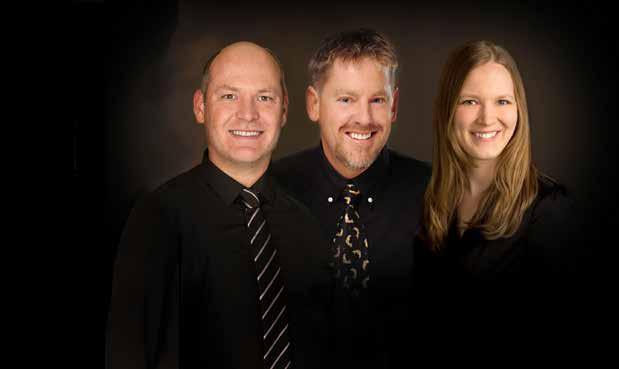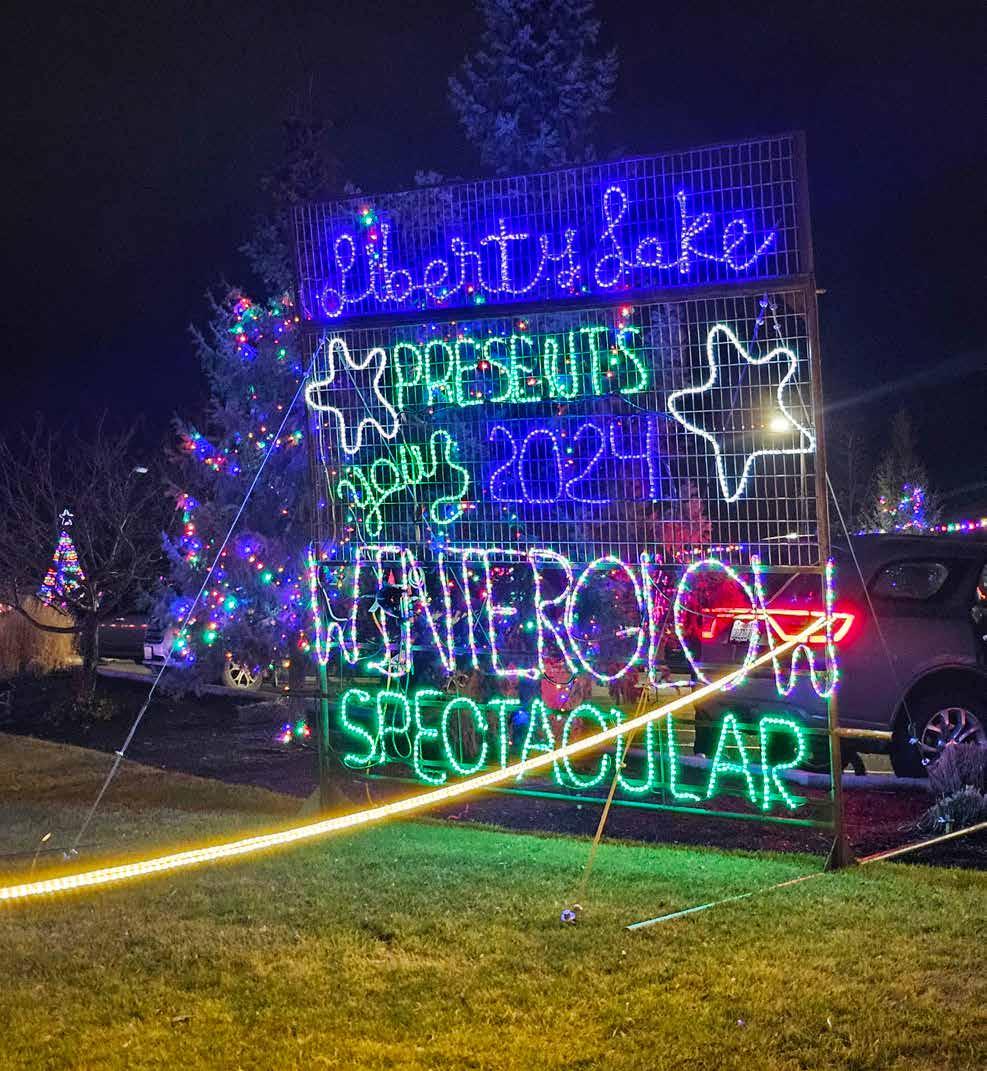
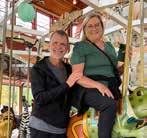

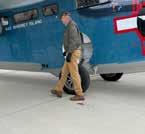





By Nina Culver
Splash contributor
Ross and Kelli Schneidmiller have long been involved in the Liberty Lake community, with Ross best known for his work to collect and preserve Liberty Lake history and Kelli known for helping launch the annual 4th of July parade. In recognition of their efforts, the couple has been named the Grand Marshals of this year’s 4th of July parade that winds through the Alpine Shores neighborhood.
Ross said that it’s a little odd to be selected as the Grand Marshals when they used to sit on the committee that selected the Grand Marshal every year. “It does feel weird to be on the other side,” he said.
Kelli, who’s great-grandfather Osmund Knudsen was an early settler, was part of a group of women who launched the first parade in Alpine Shores in 1989. Knudsen was from Norway and Kelli’s grandfather, Sig Knudsen, was one of several sons. “The first Grand Marshal was my grandpa, to honor that history,” she said. “My grandpa was born here.”
Kelli helped head up the parade for several years, then stepped back to serve on the Grand Marshal committee until four years ago when she stepped down. She recalls the early years of the parade when neighbors fired up their backyard grills to feed the neighbors. “We outgrew the backyard grills,” she said.
The parade helped the couple be more involved in the community, the couple said. “When you volunteer for something, it’s the best way to get to know your neighbors and your community,” Kelli said.
Over the years Kelli was involved in many school events as their
three daughters attended Central Valley schools. She often ended up taking notes in a notebook she frequently carried, which led to her involvement in numerous programs and projects. It was something her husband often teased her about. “I would say ‘Honey, put your hands in your pockets and don’t bring a notebook,’” Ross said.
Along the way Ross became dedicated to preserving Liberty Lake history. The small lake used
to be dotted with resorts and was a regional destination, partly because of a large dance pavilion that stretched over the lake. There was also a carousel at the lake for decades and at one point Ross began researching what had happened to it. He found it in the Greenfield Village at the Henry Ford Museum of American Innovation in Michigan, where it was restored. He and Kelli have since visited the carousel, posing for pictures with the frog that many will recognize from the historical mural at Pavillion Park.
The couple have collaborated on small historical displays at the two elementary schools in Liberty Lake, changing the displays each year. “We used to go to a lot of antique

shows, a lot of antique malls, looking for things,” Ross said.
The couple would look for genuine Liberty Lake artifacts or items that would help illustrate the history. “He has pictures and such knowledge,” Kelli said. “It’s fun to find the embellishments to bring it to life.”
The couple has also helped make a bit of history. Ross’s family donated the land that would become Pavillion Park and were involved in the Friends of Pavillion Park to help raise money and find volunteers to create the park.
One of their hobbies is to dress up in vintage clothing and participate in vintage swing dances, including the annual Avalon Ball on Catalina Island off the coast of California. They also own an antique boat that they display in boat parades and boat shows.
“We kind of feel like we’ve stepped back into some of those old pictures we have,” Ross said. “It’s a lot of fun.”
The 4th of July parade through Alpine Shores begins at 11 a.m. People with decorated golf carts, bikes or wagons can line up at Shoreline and Liberty Drive beginning at 10 a.m. to participate in the parade.
Q: How did you and your wife meet?
A: Kelli and I both grew up at Liberty Lake and attended Liberty Lake Community Church. We were both involved in our respective youth groups but because of the age difference we were merely acquaintances. Returning home from our respective universities in late spring of 1982 we were told of a new Sunday School Class starting for younger members of the congregation. What we were not told was that it was a young marrieds’ class. Surprised and a little red faced we decided the church needed a young singles group. We became the best of friends organizing the events.













Q: How did you first start learning about Liberty Lake’s history?
A: Liberty Lake had a thriving resort community during our youth. But besides living some of that history from the late 1950’s and beyond there were many visual reminders to Liberty Lake’s past. Remains of older resorts, homesteads, irrigation canals and the brick schoolhouse existed for years. These slowly disappearing structures prompted questions from which we learned. But I caught the history bug from the stories Mildred Brereton shared with her Sunday school class about growing up at Liberty Lake during its heyday. But for Kelli it is different; Liberty Lake history is part of her family’s heritage.
Q: What was it like for Kelli to grow up in a resort family here at the lake?
A: I grew up hearing lots of stories! Too many to mention; some from the hills, others from Wicomico Beach and Liberty Lake Park (now Alpine Shore neighborhood). My great-grandparents homesteaded in 1889 up on the hill beyond the County Park. My parents met as teenagers waterskiing at the lake— Dad’s family had Sig’s Resort on Wicomico Beach. Mom was a “city girl” whose family bought a summer cabin south of Dreamwood Bay. At Sig’s I learned how to help with launching boats, cleaning the beach, selling gas and flatten patties for my grandma’s famous hamburgers. I had one year before they sold and retired when I was lucky to be tall enough to place orders for the kitchen, sell candy, scoop ice cream and count back lots of change. When I was sixteen I rode my bike over to Sandy Beach and the Dolphin’s hired me to help at their resort. I loved it all!
Q: Do you have a favorite Liberty Lake artifact and is it in your collection or someone else’s?
A: I can’t say I have a favorite, but I do treasure some more than others. Items that come with a good story, took years to find or are unique I do favor more. Except for common postcards the artifact yield to time spent looking is extremely low. So, one day Kelli walks into an antique
shop and asks the storekeeper if they have anything from Liberty Lake? A question I had mostly stopped asking by that time due to its ineffectiveness. The response was “I just got something in.” It was a celluloid pin with Uncle Sam depicted and the words “Big Liberty Lake Celebration July Fourth“ with a mock firecracker tethered to it, circa 1912. It is really cool and was a Father’s Day gift years ago.
Q: What is something that came out of volunteering you did not expect?
A: Working on the parade taught us how to live better at the lake. With our responsibilities for the event combined with displaying and sharing history we were often some of the last people there. Our invited guests had returned to our house long before we arrived, and we had not been missed. People were content and enjoying one another and there were years we hosted and fed nearly 100 people. Kelli’s words of “we are going to keep it simple” ring in my ears. To be fair good planning was part of it, but our guests were more than capable to figure the unexpected out. Learning this lesson was a gift and has allowed us to enjoy where we live even more.
Q: Is there a particular historical story about Liberty Lake that you think most people don’t know?
A: I have enjoyed connecting Liberty Lake to historical events and people beyond the boundaries of the community, area, state or even the country. That is when our history comes alive to me. Most people I find are unaware of these links but enjoy learning about them. Some examples are Liberty Lake’s connection to Women’s Suffrage, early pioneering of flight or links to several U.S. Presidents. I enjoyed writing the article about when the Medical Lake Soap Company advertised that they were making super large bars of soap to wash circus elephants in Liberty Lake. When I find something interesting, I usually write about it in the Splash.
Q: Why is it so important to you to continue to collect and share Liberty Lake’s history?
A: Liberty Lake’s History helps define our community. To think that since the 1850s gathering, recreation, music and education have been a big
part of our culture here is amazing. These deep roots are something to celebrate as they add to our identity. But it is the connection to people that keep us pursuing and wanting to share. Our doorbell rang a couple days ago, and it led to a delightful stroll down the Wicomico Beach sidewalk and memory lane. A couple from the west side were visiting the childhood recollections of the 85-year husband. As he shared his story with questions, and I filled in details; his joy was contagious!
Q: Tell me about your visit to see the Liberty Lake carrousel at the Henry Ford Museum in Michigan. Were you able to ride it?
A: In September of 2023 we visited the Herschell Spillman Carousel in Dearborn Michigan. It was our third time we had been to Greenfield Village--the open-air history portion of The Henry Ford Complex. There is so much to see there and worth the trip but for us the carousel is the draw -- returning several times over our two days stay to watch and ride it. Doing oral histories over the years we heard several stories about when the carousel was here at the lake and what their favorite animals to ride were. If you closed your eyes and listened, you could hear the children saying along with the calliope music, “I want to ride on the frog, the zebra etc”...and we were mentally transported back to a time gone by at Liberty Lake. (The carousel was actually the first item Ross researched in 1985!)
Q: You both have had a long history of community service in Liberty Lake. What accomplishment do you see as the most impactful?
A: Of all your questions this one required the most thought and discussion yet ended without a conclusion. We have been fortunate to work on projects and events that we felt were important for our community. The community members we worked alongside brought dedication and talents resulting in lasting traditions and treasured community amenities. The impact of our community service in preserving history, helping to get things started at Pavillion Park, working together to create or continue traditions or to support education depends a lot on what happens in the future. Which is why we are supporters of the Liberty Lake Better Together Fund.




















are YOUR priorities for Liberty Lake’s next city
Let us know this summer!
What are YOUR priorities for Liberty Lake’s next city budget? Let us know this summer!
City of Liberty Lake staff members are already starting to develop the city’s budget for 2026 to determine what services and projects will best serve residents’ needs. During July, the city’s website will again be starting up some public engagement opportunities that will offer residents several opportunities to share their thoughts on the funding priorities with city leaders.
Watch for those interactive engagements as they are posted on the City of Liberty Lake’s Facebook site. You’ll also be able to find those by clicking the “Engage Online” button on the city’s homepage and going to the “City Budget Development for 2026” section, which also offers a timeline of the upcoming budget process.
Touch A Truck is wheeling into Orchard Park on July 18
The annual Touch A Truck attraction will be making its return trip to Liberty Lake’s Orchard Park on Friday, July 18, from 10 a.m. to 1 p.m. This popular free event from the Liberty Lake Municipal Library gives kids and families some up-close views – and lots chances to get into – vehicles such as construction equipment, snowplows, emergency vehicles, police cars, military trucks, and more.
In addition to all the heavy

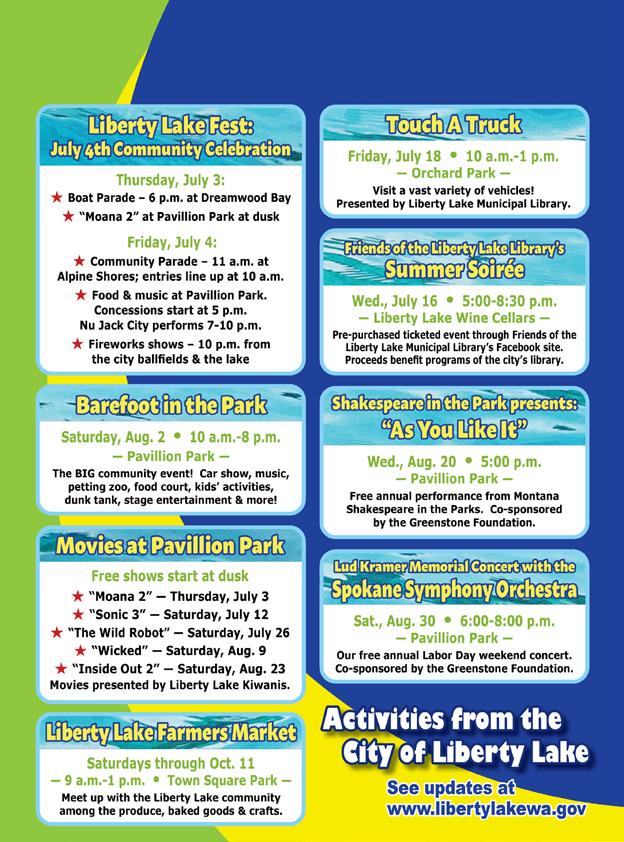
wheeled attractions to explore, Touch A Truck will also feature some inflatable play sites for kids. Plus, there will be a fully operational ice cream truck, snow cone truck, and mobile coffee stand with items
that attendees can purchase. Some of the partners lined up for the 2025 edition of Touch A Truck include: The City of Liberty Lake, The Children’s Choice for Pediatric Dentistry, Numerica Credit Union, Liberty Lake Police Department, Liberty Lake Post Office, Spokane Valley Fire Department, Liberty Lake Police Tribute Car, Western CAT, Papé Machinery, U.S. Air National Guard, and Two Men and a Truck.







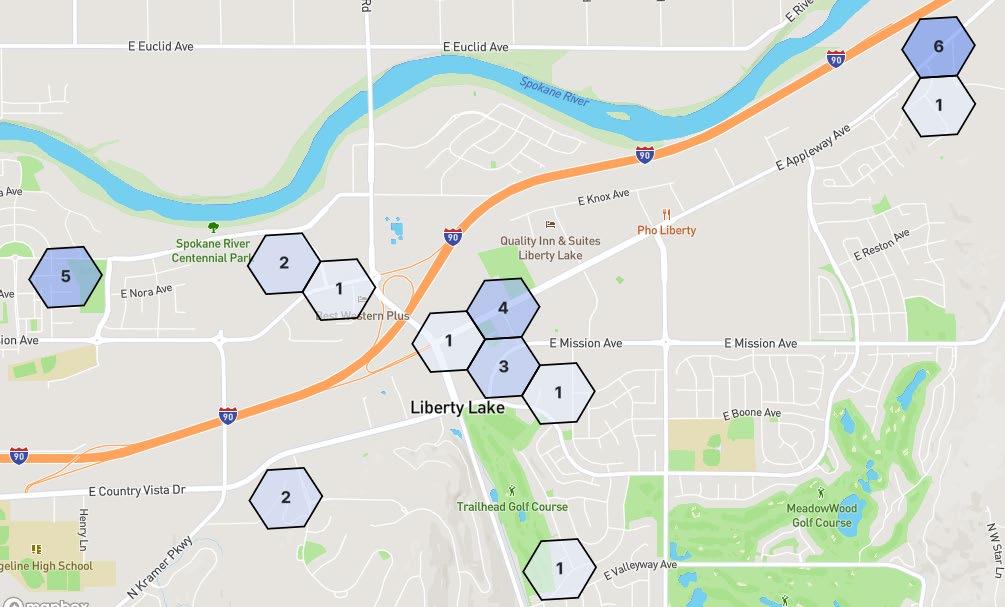
2025-88005188:


On 5/7/2025, a vehicle prowl occurred at Orchard Park. The victim was able to capture the suspect’s license plate. Officers were able to determine who the suspect was based on that information and were able to make an arrest for the vehicle prowl violation.
2025-88005153:
On 5/9/2025, a stolen vehicle alerted on the Flock cameras. Officers responded and attempted a traffic stop, but the vehicle fled. A pursuit was initiated but had to be terminated due to the volume of traffic on the road. The vehicle was located again a short while later and again failed to stop. The driver fled on foot and ran into the river. Outside agencies were called to assist and the suspect emerged and was taken into custody.
2025-88005362: VEHICLE PROWL/ FRAUD
On 5/11/2025, two male suspects prowled a vehicle in Airway Heights and used the stolen cards at several locations, including Home Depot in Liberty Lake. Suspects have been identified but not arrested. The detectives are following up with this investigation and have sought a warrant for the suspects who were identified.
The Liberty Lake Police Department would like to remind everyone to drive slowly and safely in all marked school zones and neighborhood areas. The activity in those areas will increase as the summer kicks off and the kids get out of school. Take additional time to be aware of the pedestrian traffic. The Liberty Lake Police Department has had an increase in speeding violators and are proactively enforcing those high traffic areas. Remember to secure your belongings inside your residence and out of your vehicles to prevent vehicle prowlers as the summer months tend to invite more prowling activity. Stay well and be safe!
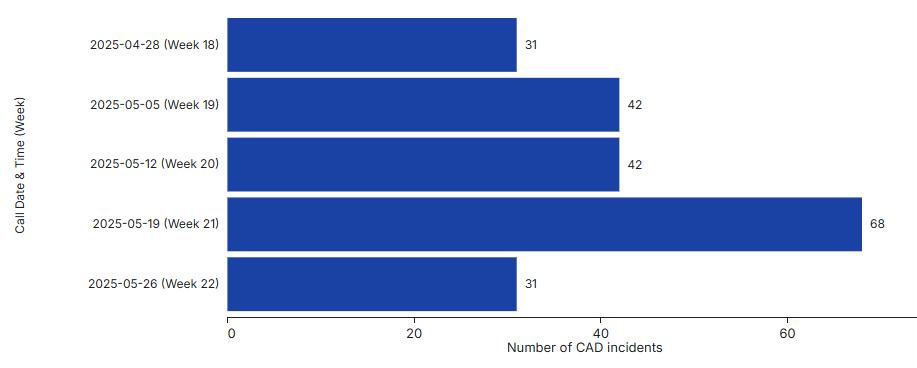
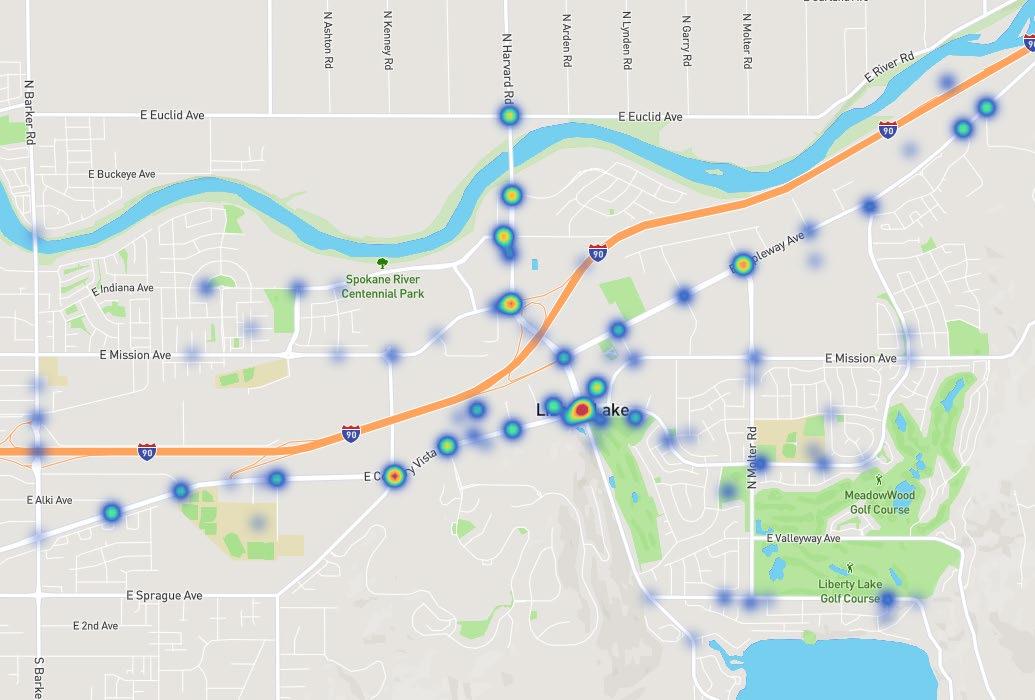






By John McCallum Splash contributor
This December, for the first time in six years, the River District’s Orchard Park will be dark.
No lighted animals gracing tennis court fences. No “North Pole” themed entrances.
No holiday train electrically chugging along. No singing Christmas trees.
No guitar playing Santa Claus.
Winter Glow Spectacular, the December holiday celebration of light that has brightened Orchard Park and the city of Liberty Lake through the depths of winter since 2019 has ended its run after the city and Winter Glow Foundation members failed to reach an agreement to pass event ownership to Liberty Lake.
How those discussions failed depends on who you talk to. The city
announced in a June 13 news release that attempts to “reach an equitable agreement with the nonprofit” made it clear “no partnership is possible.”
“As a result, Winter Glow Spectacular will no longer take place in Liberty Lake,” the release continued.
At a June 3 meeting, City Administrator Mark McAvoy told City Council members the city had reached a tentative verbal agreement with Winter Glow where the organization would produce the event for one more year. Winter Glow would then transition to the city in 2026, with staff and council deciding then whether to continue it as is, modify it or discontinue it altogether.
McAvoy proposed creating a Memorandum of Understanding (MOU) with Winter Glow to this effect. The MOU would still leave
the future of the event up in the air, but it would stop the “countdown clock” that was ticking to a June 16 deadline set by the board as to whether or not the city would take up the event.
In a June 23 interview, McAvoy said the basics for the verbal agreement sprung out of the June 2 town hall to get public sentiment for the event — which gauged by audience input and some polling during the meeting was overwhelmingly positive towards continuing Winter Glow.
During the meeting, Winter Glow production director Richard Reilly answered a number of audience questions about the event such as setup requirements and sponsorships. McAvoy said he reached out to Reilly the next day to discuss a potential arrangement to stage this year’s event while other details were being worked out.
McAvoy said there was a verbal agreement, which he presented to the council that night. But in a subsequent communication with board members shortly after, things
went sideways, he said.
The board began making several “non-starter conditions” on an agreement, such as upfront payment for the event’s inventory and guarantees of payment for expenses, something normally done through the reimbursement process as part of the city’s lodging tax distribution process.
These conditions turned out to be a “deal breaker.”
“At the end of the day, they wanted more than we were willing to give,” McAvoy said, stressing he felt they had a verbal agreement to continue Winter Glow.
Hearing different things
Winter Glow director of marketing Shirlene Ingraham tells a different story. Ingraham said in a June 23 interview the phone call between McAvoy and Reilly was an “off the record” discussion conducted without the board’s input.
At the town hall, Reilly mentioned that several local businesses and individuals had taken personal

“ownership” of specific Winter Glow displays by insisting on providing the labor to set them up and take them down after the event, thus maintaining expertise in the operation. Ingraham said Reilly committed himself in the phone call to providing such expertise by continuing to help the city with the event.
“Mark heard something different than what Rich said,” Ingraham said. “Mark heard the board would do it.”
Ingraham stressed that if Liberty Lake assumed production of Winter Glow the board would help out in an advisory capacity with the transition, serving only as a guide. The board itself has essentially “dismantled” over the issue of continuing Winter Glow, she said, adding a lot of “hard work” has gone into bringing a quality production to the community.
“There was no board decision ever to do what Mark said we would do,” Ingraham said. “It’s a bad, bad deal.”
Ingraham said they sent an email to McAvoy after the MOU discussion suggesting setting up a face-to-face meeting, but he replied the city was no longer interested in pursuing an agreement.
Hard numbers
Up until early June it seemed a possibility the city might take up the Winter Glow Foundation’s offer to take up producing the event. The board had contacted Liberty Lake staff this past January with an offer to sell the city the event name, all of the displays and their storage containers for $25,000, citing aging and tired board members, desire to focus on smaller events and dwindling volunteer base needed to set up and maintain the displays as reasons for the move.
At an April council workshop, McAvoy presented numbers to members on what it would take for the city, using staff hours, to produce Winter Glow, a figure that reached almost $600,000 in materials, services and labor over 2025-2028. In contrast, using volunteers and labor from Geiger Corrections Center, Winter Glow staged the event over 2022-2024 for $99,635, part of which included receiving $82,000 in Liberty Lake lodging tax funding including $25,000 for 2025.
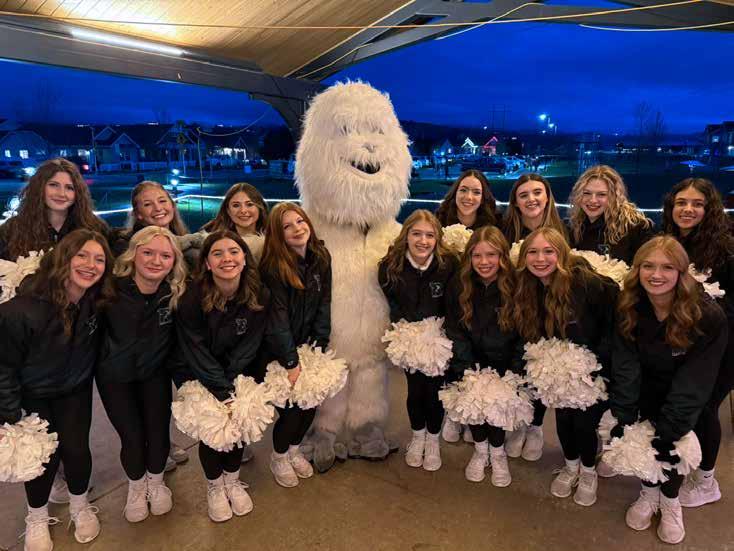
McAvoy told council it was city staff’s recommendation to not accept the Winter Glow board’s sale offer. Part of this stemmed from the number of hours it would take to produce the event, with city staff estimating that at almost four times the 1,770 hours event organizers said they put in.
Council members seemed receptive at the April meeting to the idea of taking on the event, and citizen input was sought via the June 2 town hall.
At that meeting at Trailhead, city staff presented more concrete numbers on costs and time. City financial contributions over the past five years were pegged at $129,635, a figure that included the 2025 lodging tax distribution and a $20,000 one-time payment in 2021 from federal American Recover Act (ARPA) funds.
Winter Glow board members in attendance told the audience they
also contribute financially through fundraisers throughout the year, such as a golf tournament, as well as sponsors. Reilly noted that the 2024 budget was $60,000, which included labor from Geiger.
Financial figures for Liberty Lake production of the event from 2025-2029 totaled $480,012, of which $363,975 was for labor and $116,037 was for materials and services. Staff told the audience they hadn’t included the possibility of receiving volunteer labor to help with the event because how many volunteers would step forward was unknown.
What was known was a labor comparison of 6,496 hours for city staff against 1,770 for Winter Glow volunteers. The comparison was over the November – January timeframe for the event, including set up and tear down.
McAvoy said in the June 23 interview the figure was for hours staff was already working during that time period on city related tasks.
“In other words, we don’t have idle time,” he added about producing the event, which could take the hiring of at least one fulltime staff member to put on.
Community enthusiasm, council concerns
Liberty Lake residents attending the town hall were overwhelmingly in favor of seeing Winter Glow continue, even if the city were to produce it.
In online polling, 76.09% indicated it was extremely important / important the event continue in Liberty Lake, with 84.44% supporting the city taking over management. A big majority, 82.98%, wanted to keep it at Orchard Park while 77.27% said they hoped visitors to the city would provide enough revenue in sales taxes to cover the costs or supported another funding option.
Continued from page 11
A wide variety of ideas were tossed out on elements like additional features they would like to see at the event, other funding ideas such as more food vendors, getting more local sponsors and ways of enlisting volunteers to help reduce city expenses.
The enthusiasm of the town hall was a contrast to the guarded discussion council held the next day on the proposed MOU. Some member concerns centered on a lack of specifics in the agreement for the city going forward, how it would impact future city budgets as well as the amount of staff time required to stage the event.
“That was my hesitation all along, was the burden it puts on all of you,” Mayor Pro Tem Chris Cargill said.
Councilman Dan Dunne spoke in favor of the proposed agreement, calling it a “win-win” for all parties in that it allowed the event to be held in 2025 while also letting the city plan ahead in a “low pressure environment” for future impacts to staffing and finances.
The member with the most forceful concerns was Councilman Mike Kennedy. Kennedy stressed that taking on Winter Glow was going to require a lot of council discussions about whether that was the direction they wanted to go, especially given other financial issues facing Liberty Lake such as paying for capital facilities such as a new City Hall and the proposed Town Square library/community center.
Those projects will require an additional $13.5 million in revenue to help complete, Finance Director Kyle Dixon told the council. Kennedy said he was supportive of Winter Glow, and acknowledged the level of support for it in the community.
“But at what cost are we going to do this?” he asked. “Is it a priority over the library? City Hall? I don’t think so.”
Kennedy also voiced concerns about the lack of specifics of what it would mean for the city to take up Winter Glow after this year, expressing worries about creating obligations the city couldn’t afford.
“I am very concerned about that,” he added. “This council has to put the time and effort into having discussions about this.”
McAvoy said staff would incorporate those concerns into a draft MOU and return to council at the June 17 meeting to gather further input — a task that was made moot just a couple days later.
Keeping winter glowing, somehow
Ingraham said she watched the video of the June 3 council discussion about Winter Glow. The feeling of reluctance from the group for an agreement was evident.
“They didn’t want to commit, you could feel it in the tone of their voices,” she added.
McAvoy said it was disappointing not to have Winter Glow as a holiday attraction this season. He added city staff is working on some possible holidaythemed options for the city, potentially this year — something he felt was expressed during the town hall.
“We got a pretty clear indication they (citizens) value that kind of thing,” he said.
“We’re devastated to not see it picked up and continued,” Ingraham added of Winter Glow, noting 50% of the money raised was donated so families can have a free, fun event.
The possibilities for the event to continue are still there, she added, but it’s getting late in the year. The Foundation has prepared letters to send to some community groups and businesses to ascertain if there is interest in purchasing the event to keep it going, especially in 2025.
If that does happen, Ingraham said the board would be there to support the future producers of the event with their expertise and guidance.
“Hopefully another business or group will reach out to WG (Winter Glow) so the lights can stay on in Orchard Park with holiday displays,” Ingraham said in a text message. “We put a lot of hard work into giving Liberty Lake this free holiday lighting event. Our whole mission is to bring back the spirit of Christmas, to every person and family to enjoy for free.”




THURSDAY, JULY 3RD
- Line up 5:15 pm @ Dreamwood Bay
- 6 pm travelling counter clockwise
- No registration needed, show up decorated and get in the lineup. Cash awards will be given for Best Overall, Most Patriotic, Best Themed, Best in show
- Live music and patriotic music.
Moana 2 - Starts at dusk (around 9 pm)
Pavillion Park
- Bring your lawn chair and/or blanket to get cozy and enjoy an evening movie with your friends and family.
- Consession stand will be open.





- Line up at Alpine Shores on Shoreline Drive
- 10:45 am announcements from the mayor, introduce grand marshalls
- 11 am line up, no registration needed. Bring your wagon, golf cart, or walk through the parade! Liberty Lake community band. Please no cars, pets or political affiliated groups.
- Parking available at church and along Gary
- Alpine Shores hosts games after the parade
- 5 pm to 9 pm concessions open

- 7 pm Live music performed by Max Daniels & Nu Jack City
- 10 pm fireworks will be launched from the baseball field between Liberty Creek and Liberty Lake Elementary School.
- 10 pm show start. See map for launch location
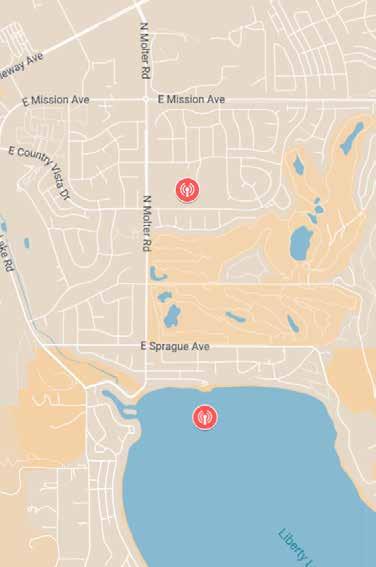




Dedicated Ridgeline Percussion Regiment and recent graduate, Aiden Ajos played the tenors all four years of his time at Ridgeline High School. Ajos played the Tenors in the Marching band and indoor percussion serving in a leadership role as Percussion Co-Captain his last year at Ridgeline. Ajos also played the drum set for the school Pep Band and in his sophomore year placed 3rd in the state for music in multi-percussion and was the first person from Ridgeline to achieve a state ranking in music. Aiden is also involved at The Intersection church where he volunteers to play drums as well as volunteers in the daycare center. Outside of music, Aiden participated in the school Track team competing in the Pole Vault and Javelin events and in his senior year participated in the school Musical production Cinderella as a page boy and apart of the singing ensemble. Aiden has enrolled in the Spokane Community College Fire Science program and wants to become a Fire Fighter. When asked what inspired him he says “Ever since I was a kid, I wanted to help people.”

Ridgeline High Schools incoming senior Madilyn Crowley has been playing basketball since she was in the 1st grade. This last year Crowley, a 6’1” tall Power Forward averaged 16 points, 9 rebounds, and 2.3 assists per game. Madilyn also plays for the Northwest Blazers Club while maintaining a 3.9 GPA at Ridgeline. Off the court Crowley is a member of the Link Crew, Honor Society, and looks forward to joining the Ridgeline Key Club this fall. Madilyn enjoys volunteering with the Ridgeline Kids Basketball Camps, volunteering at the Liberty Creek Elementary School, and has volunteered as a basketball coach when needed. When looking to the future Madilyn hopes to play basketball in college “I’ll go wherever I can play” and plans to study either business or economics. Outside of school Madilyn has also volunteered as a puppy foster program and made meals for the homeless downtown

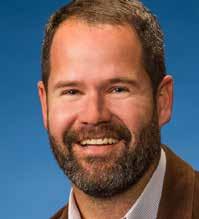
Trent Maier is the owner and President of Trailbreaker Cider, a family-owned hard cider manufacturer based in Liberty Lake that also features a brewpub style restaurant and event center. After earning his Bachelor’s degree in Electrical Engineering from Michigan State University in 2003, he spent several years within the auto industry as an automation engineer before moving to the Pacific Northwest to pursue a similar career in the energy sector. In 2011 Trent shifted gears to follow the dream of owning his own business by moving to Seattle and attending culinary school in order to learn more about his true passions – Food & Cider. His pursuit of starting his own cider company began with a meeting alongside his good friend and future business partner, Brian, who mistakenly introduced Trent to his sister Stacie and the rest as they say, is history. Trent currently serves on the Board for the Greater Spokane Valley Chamber of Commerce and was board president in 2023.


Thanks you for all you do in our community


















By John McCallum Splash contributor




Senior Daden Lewis wrapped up his high school track and field career with a third-place finish in the discus at the 3A state meet May 29-31 at Mt. Tahoma High School in Tacoma. Lewis set a new personal record of 175 feet, 4 inches to wrap up a medal, out-distancing fourth-place Tanner Larson of Kennewick by 11 inches and just missing a runner up slot by 4 feet, 1 inch to Peter Smith, also of Kennewick.
Will Foster of Prairie High School won the state 3A title of a PR throw of 194-04.
Lewis also placed eighth-place in the shot put with a toss of 51-0.25.
Tanner Hamblin missed the finals in the 110-meter hurdles at state. The senior had a preliminary time of 15.99 seconds, finishing 12th overall and out of the top-eight by 68/100ths of a second.
The Falcons had four players receive First-Team All-Greater Spokane League selections along with two honorable mention picks.


















The RHS Track & Field season completed with two athletes placing at the State Championships! Senior Daden Lewis finished 3rd in the discus with a personal record throw of 175’4” inches. The 2nd Team All GSL thrower also made the podium with an 8th place finish in the shot put. Senior and newly-named prom king, Tanner Hamblin, also competed, representing the Falcons with a 12th place finish in the 110 high hurdles.
Junior Caden Andreas was named GSL Offensive Player of the Year along with being a first-team selection. Joining him on the team were juniors Ben Wartinger, Mikey Macall and Charlie Lynn. Honorable mentions were junior Nolan Wohl and sophomore Braxxton Barker.
“In addition to Caden being name OPY, Mikey Macall was near or at the top of most offensive categories across the league and Ben Wartinger was arguably the best pitcher in the league this year,” Ridgeline head coach Jeramie Maupin said in an email.
The Falcons finished 9-9 in the GSL, fifth, and 11-14 overall. While they weren’t successful in defending the program’s first ever league title,
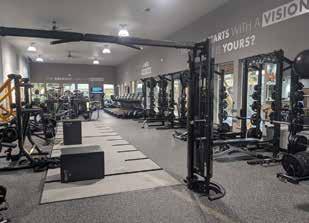
they did reach the playoffs for the first time.
“While this year was very up and down, we got hot at the right time and qualified for the state tournament for the first time in school history,” Maupin said. “Unfortunately, we lost to Shorewood 5-3 in the first round.”
Fastpitch softball
Three Falcons received All-GSL honors this season. Senior Lilley Triplett was a first-team selection in the outfield while junior Quincy Coder was second-team for utility and sophomore Persais Triplett received honorable mention for pitching.

Lilley Triplett ends the year with a .683 batting average and was the GSL leader in homeruns with 10.
The Falcons placed fourth in the GSL with an 11-7 record, 12-10 overall. Seeded sixth in the district playoffs, Ridgeline fell 9-4 to No. 3 Kennewick, but rebounded for their first playoff win with an 8-6 victory over GSL rival Cheney.
Needing two more wins to reach state, the Falcons season ended with an 11-1 loss to top-seeded Southridge.
The Falcons placed four on the All-GSL rosters. Senior Carolyn Rose was a first-team selection with senior Kate Mulligan and sophomores Chloe Hamilton and Morgan Quesnell second-team picks.
Ridgeline placed third in the GSL overall. The won their second straight District title by 70 strokes over second-place Southridge.
The Falcons placed five players on All-GSL teams. Senior forward Andre Chaker and junior defender Thatcher Hemphill were first-team selections.
Second-team selections went to senior forward Abdul Umar Nasir, sophomore midfielder Cole Kreider and senior goalkeeper Brady McMahon.
Jackson Heib was the only Falcon named to an All-GSL team. The junior was a All-GSL first-team selection.























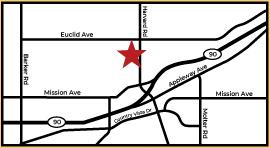
By Ross Schneidmiller Liberty Lake Historical Society
To say the Grocers’ Picnic required planning by the entire Spokane community is misleading without some explanation. That is because every grocery store and butcher shop in Spokane was closed on the day of the annual event. Along with advertising that alerted wouldbe shoppers, many of the markets would stay open late the night before to accommodate their customers. Those who failed to plan provided good business for local eateries.
Special trains were arranged for the day to haul grocers, butchers
and their families to the picnic site. Liberty Lake Park was often the location chosen to host the event.
Soon after the first six-car train reached the lake on a July morning in 1914, the first of two baseball games began. It was a lively occasion and became even more so when an ornery fielder punched a base runner. The game was won by the Armour Meat Packers over the Greenoughs Market, 12-9. Each player on the winning team was awarded a sack of flour.
After a basket lunch was enjoyed for the midday meal, the second ballgame got underway. The TruBlu Nine of the biscuit company marched off with the sacks of flour, triumphing 11-7 over the Blodgett Mercantile.
By the end of this picnic the phrase, “To the victors go the spoils” underwent a slight change. The word “flour” would be substituted for “spoils” as four area flourmills donated sacks of their products to be
awarded as prizes for the event.
Along with boat rides and swimming, the afternoon was filled with a number of novelty races and dashes. The lead-off event was a race for men over 200 pounds. This was entertaining largely because of a sizable pond of mud and water at the finish, through which three of the contestants wearing their Sunday best plowed face first, sending splatters of mud to all sides. Their long sleeve white dress shirts were no longer dry, white or clean but they may have been the lucky ones as the Inland Empire had been experiencing a heat wave.
The rule of the day was to have fun but that did not mean the contests were not competitive. This was displayed most in the free-forall 100-yard dash where practically all the runners were decked out in spiked shoes and tracksuits.
Some of the other afternoon contests included the single ladies
race, running broad jump, grocers and butchers tug of war, ladies tug of war, sack race, potato race, pie eating contest, 50-yard swimming race, boat race with one set of oars and a contest to determine the biggest family on the grounds.
Starting at 8 in the evening, dancing was the most popular way of shelving the necessity of opening for the early morning trade at the market or store. The committee in charge reported that 4,000 single dance tickets were used. The last competition of the day was known as the “Prize Waltz.” The winning couple received a photo session for the lady and a new hat for the gentleman.
When the last dance ended, most returned by train to Spokane, many singing, laughing and reminiscing of the day’s events. Only when the late-night revelers departed on their neighborhood trolleys, did the picnic come to an end.

The Splash is committed to serving Liberty Lake through excellent community journalism. We can’t do it at all without you, our readers, and we can’t do it for long without support from our advertisers. Please thank our business partners and look to them when offering your patronage.
Our sincere appreciation to the following businesses for their foundational partnerships withThe Splash and its partner publications:



EDITOR/PUBLISHER Ben Wick ben@libertylakesplash.com
CO OWNER Danica Wick danica@libertylakesplash.com
CONTRIBUTORS
Nina Culver, John McCallum, Ross Schneidmiller
The Liberty Lake Splash P.O. Box 363 Liberty Lake, WA 99019 Phone: 509-242-7752 www.libertylakesplash.com
The Splash is published monthly by or before the first of each month. It is distributed free of charge to every business and home in the greater Liberty Lake area. Additional copies are located at drop-off locations in Liberty Lake and Otis Orchards.
The Splash is brought to you by
Submitted materials
Publishing House
Announcements, obituaries, letters to the editor and story ideas are encouraged. Submit them in writing to editor@libertylakesplash.com. Submissions should be received by the 15th of the month for best chance of publication in the following month’s Splash.
Subscriptions
homes in Spokane, Spokane Valley, Liberty Lake, Post Falls & Coeur d’Alene.
Liberty Lake residents receive a complimentary copy each month. Subscriptions for U.S. postal addresses outside of the 99019 ZIP code cost $20 for 12 issues. Send a check and subscription address to P.O. Box 363, Liberty Lake, WA 99019. Subscriptions must be received by the 15th of the month in order for the subscription to begin with the issue printed the end of that month.
By Nina Culver Splash contributor
Despite a gloomy start to the day, hundreds of people gathered at Felts Field in Spokane Valley on June 21 to participate in the annual Neighbor Day celebration, checking out aircraft old and new parked on the flight line.
The small airport on the southern shore of the Spokane River in Spokane Valley bustles with activity most days as numerous small planes come and go. It’s also the home base of helicopters belonging to the Spokane County Sheriff’s Office and Life Flight.
The gates are opened to the public once a year for the neighbors who regularly watch aircraft come and go, said Spokane International Airport Marketing and Communications Manager Alannah Toft. “It’s for the surrounding community,” she said. “Unless you’re flying, you don’t really know what goes on inside the gates.”
Helicopters from Inland Helicopter regularly buzzed in and out during the event, offering paid tours of the Valley.
Following
Of
Correction policy
The Splash strives for accuracy in all content. Errors should be reported immediately to 509-242-7752 or by email to editor@libertylakesplash.com. Confirmed factual errors will be corrected on this page in the issue following their discovery.
Advertising information
Display ad copy and camera-ready ads are due by 5 p.m. on the 15th of the month for the following month’s issue. Call 509-242-7752 for more information.
Advertising integrity
Inaccurate or deceptive advertising is never knowingly accepted. Complaints about advertisers should be made in writing to the Better Business Bureau and to advertise@libertylakesplash.com. The Splash is not responsible for the content of or claims made in ads.
Copyright © 2025
All rights reserved. All contents of The Splash may not be reproduced without written permission of the publisher.
But the stars of the show were the antique aircraft on display, many meticulously restored by aviation fans to their original appearance. Among the oldest were two Boeing Stearman biplanes emblazoned with “U.S. Army” on the underside of the wings. The planes were often used before and during World War II by the Army and Navy to train military pilots.
Also on display was a World War II Grumman Goose, an amphibious airplane used by the U.S. Navy. The plane was the first single-wing and twin-engine plan designed by Grumman, first built to transport rich businessmen. During the war, it was often used as a military transport.
Retired Air Force Major John Boyle was on hand to answer people’s questions about the plane. The one on display had been given to Britain for use during the war before being returned to the United
States and eventually sold as surplus, Boyle said. The plane could carry nine people and had a range of 1,000 miles.
Boyle doesn’t own the blue plane with “NAS Whidbey Island” stenciled on the side, but knows a lot about it. Though he was a private pilot, he never flew for the Air Force, instead serving as a public information officer for 20 years. “My eyes weren’t good enough for the Air Force,” he said.
The Goose is based at Felts Field and Boyle said he often helps by providing information about it at special events. “I help out and answer questions at events like this,” he said.
The plane is owned by Addison Pemberton, who bought it in 2012 as a hulk. Pemberton said he found it in a play yard at the Palm Springs Air Museum, where children climbed through it freely. “We brought it up here and spent five years putting it back together,” Pemberton said.
He owns Pemberton and Sons Aviation, which restores antique airplanes. Between him and his sons, the family owns 12 vintage airplanes, six of them biplanes, housed at Felts Field. Several of them were on display during Neighbor Day.
“We have eight hangars on the field,” Pemberton said. “I like to
support the airport.”
Pemberton said he has restored 23 airplanes during his career. “I started buying and flipping airplanes in high school,” he said.
Pemberton said he doesn’t have a favorite among the antique aircraft he owns. “I love the vintage airplanes, they’re all unique,” he said. “All of the airplanes do different things.”
Though vintage airplanes are his passion, Pemberton also owns the manufacturing company Scanivalve in Liberty Lake. The company makes intelligent pressure and temperature measurement instrumentation, including those used in wind tunnels.
Neighbor Days also included several informational booths, including a display by the Mobile Military Museum. On display were several former U.S. Army vehicles, including jeeps and an ambulance that wouldn’t have been out of place on the set of the M*A*S*H television show. Some vehicles and airplanes were open for tours and lines of families with young children lined up to take a look inside.
On display in one of the hangars was the mostly intact shell of a PBY amphibious aircraft with an external radar dome and machine guns mounted near the tail. The plane was known for low level

reconnaissance over the ocean during World War II and could stay airborne for 15 hours. There are plans to restore the aircraft to flight condition.
Many of those in attendance held their phones in their hands, taking photos as they went. Kevin Liechty, a photographer, had a large camera slung over one shoulder. A former Cessna pilot, he was just there to enjoy the planes. “Those are my favorites,” he said, pointing to the Stearman biplanes. “If it flies I
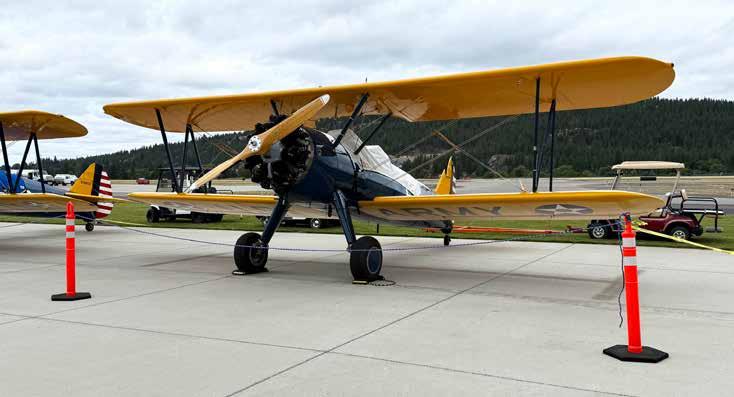
like it. My favorites are warbirds in general.”
Liechty lives near the flight path for Felts Field and often hears planes buzzing overhead. His ears are always perked for a “round” engine, the type used in antique airplanes. “When they fly over the house, my wife knows I’m running outside to the deck when I hear a round engine,” he said.
Neighbor Day also celebrates the history of Felts Field, which is so old it predates the term “airport.” In the early days of aviation, there were many small air strips. Felts Field, initially called Parkwater Aviation Field, began functioning as an airstrip in 1913. It was very popular and was also frequently used by the military.
“During the early era of aviation, it was one of many,” said Toft. “Felts emerged as the prominent one.”
The field was one of the first designated as an airport in the United States in 1926 by the U.S. Department of Commerce. The airport was renamed Felts Field in 1927 in honor of Lt. James Buell Felts, a Washington Air National Guard pilot who died in a plane crash.
The airport was used by passenger airlines until the late 1940’s, when those types of planes got too big for the runways at Felts Field. The airport remained busy, however, and an air traffic control tower was added in 1966.



